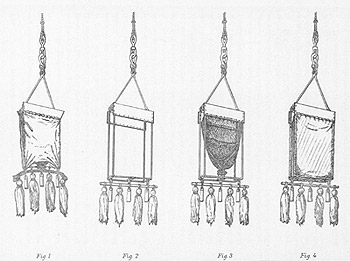 Surveying Voyages of Ships Adventure and Beagle
Surveying Voyages of Ships Adventure and Beagle The Physical Geography of the Sea
The Physical Geography of the Sea The Depths of the Sea
The Depths of the Sea The Voyage of the "Challenger."
The Voyage of the "Challenger." Deep-Sea Sounding And Dredging
Deep-Sea Sounding And Dredging Norwegian North-Atlantic Expedition
Norwegian North-Atlantic Expedition The Fisheries of the United States
The Fisheries of the United States Three Cruises of the "Blake"
Three Cruises of the "Blake" The Gulf Stream: Methods of Investigation
The Gulf Stream: Methods of Investigation Aus den Tiefen des Weltmeeres
Aus den Tiefen des Weltmeeres
Deep-Sea Sounding and Dredging: A Description and Discussion of the Methods and Appliances Used on Board the Coast and Geodetic Survey Steamer, "Blake"
This is a guidebook to the mechanics and methods of deep-sea oceanographic and hydrographic work developed aboard the U.S. Coast Survey and Geodetic Survey steamer Blake during the 1870s as it sailed the Atlantic Ocean, Caribbean Sea, and Gulf of Mexico. The work broke ground in oceanographic research for its innovative use of apparatus and equipment and its careful attention to detail and process, securing the Blake’s reputation as one of the most important research ships of the 19th century.
This excerpt includes the title page, pages 13-24, and plates 1 and 15 from Deep-Sea Sounding and Dredging.
You may need to download the Flash Player to view the book. To navigate through the book in Flash mode, click once on any page corner; click on any corner, hold, and drag the page; or use the menu at the bottom of the image. In the menu, the arrows will flip the book pages, the magnifying glass will allow you to zoom in on the page and scroll up and down the page, the printer icon will allow you to print the page in view, and the icon to the far right will allow you to view thumbnails of the included pages.
You can also view a non-Flash version.
While the British were sending their great Challenger expedition around the world between 1872 and 1876, American oceanographers were not idle. Beginning in 1874, the Superintendent of the Coast and Geodetic Survey at the time, Carlise Patterson, dispatched the United States Steamer Blake to the Gulf of Mexico, the Caribbean Sea, and the eastern Atlantic Ocean to examine deep-sea depths and temperatures, water densities, currents, and samples of the bottom sediment, water column, and fauna.
As the crew of the Challenger struggled with hemp ropes to conduct soundings and take dredging samples, Charles Sigsbee, a lieutenant-commander in the U.S. Navy and and assistant in the Coast and Geodetic Survey, and Alexander Agassiz, the only son of the famous naturalist Louis Agassiz, revolutionized how oceanographers did their work. During cruises aboard the Blake between 1874 and 1879, they modified and improved oceanographic research equipment and processes.

Disappointed that the dredge used during the Blake's early cruises (figure 1, far left) yielded few specimens when dragged across soft bottoms, Sigsbee and another crew member modified the design of the dredge (figures 2, 3, and 4–center two and far right dredges) to "skim" rather than "plow" the ocean bottom and allow sediments to “wash through” rather than clog the netting. (p. 140)
New Techniques
Sigsbee and Agassiz (ag'-uh-see) introduced the use of wire rope for dredging and other "over-the-side" oceanographic operations, replacing the traditional hemp ropes. Sigsbee created the Sigsbee Sounding Machine that vastly improved upon William Thomson's piano-wire machine developed for taking ocean depth soundings. Soundings taken by Sigsbee and Agassiz had an error of less than one percent of water depth and were taken at least three times faster than with the old hemp methods.
In his introduction to this volume, Charles Sigsbee could not conceal his competitive zeal and enthusiasm for the work aboard the Blake in comparing its accomplishments with those of the much larger and more famous ship Challenger when he wrote:
"Without specifying the great results obtained from this continuous research, I may be pardoned in referring with some gratification to the fact that in the small steamer 'Blake,' of only three hundred and fifty tons burthen, N.M., under the energetic and skillful commands of Lieutenant-Commander Sigsbee and Commander Bartlett, with a full complement of forty-five including officers and crew, more rapid work was done than had been accomplished with the old methods and appliances by the 'Challenger,' a vessel of over 2,000 tons burthen, with a complement of twenty-nine naval and civil officers and a correspondingly large crew." (p. 5)
The detailed illustrations and instructions in this work cover a multitude of state-of-the-art oceanographic techniques and technologies developed during this period aboard the Blake. They include using piano-forte wire, sounding-rods, sinkers, reeling-engines, and accessories; measuring water temperature, density, salinity, and currents; sampling the ocean bottom and collecting sea animals with trawls, dredges, and nets; and keeping good records of all this work! Much of the work on these cruises is also captured in Three Cruises of the United States Coast and Geodetic Survey Steamer "Blake": In the Gulf of Mexico, in the Caribbean Sea, and Along the Atlantic Coast of the United States, from 1877 to 1880, another seminal work that is also featured in this collection of rare oceanographic books. The Blake was indeed one of the most important oceanographic research ships of the 19th century.
- Author: Charles D. Sigsbee (1845-1923)
- Date Published: 1880
- Publisher: United States Government Printing Office
- Location: Washington, DC
- Length: 221 pages
View Complete Rare Book
Deep-Sea Sounding And Dredging (pdf, 191 MB)
Related Web Sites
Charles Sigsbee's Papers at the New York State Library
